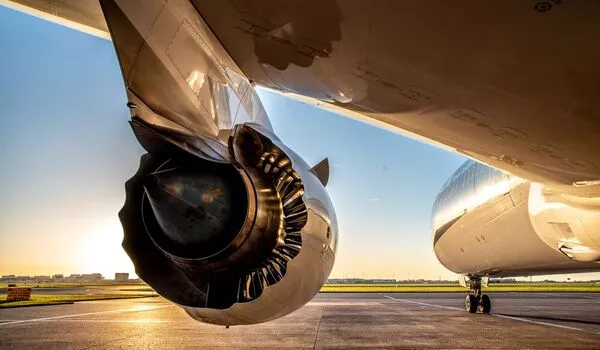Sustainable aviation energy is an important area of research and development because the aviation industry contributes significantly to greenhouse gas emissions. Several options are being investigated to reduce the environmental impact of aviation.
Scientists and industry leaders around the world are looking for answers on how to make aviation sustainable by 2050, and selecting a viable sustainable fuel is a major sticking point. Phil Ansell, an aerospace engineer at the University of Illinois Urbana-Champaign, took a thorough inventory of the options in order to make a data-driven assessment of how they compare. He reviewed over 300 research projects from various sectors, not just aerospace, to synthesize ideas and draw conclusions to help direct the conversation about sustainable aviation toward a permanent solution.
Several key energy carriers, according to Ansell, have emerged, including bio-jet fuel pathways for synthetic kerosene, power-to-liquid pathways for synthetic kerosene, liquid hydrogen, ammonia, liquid natural gas, ethanol, methanol, and battery electric systems. Ansell contrasted them with traditional fossil-derived aviation turbine fuel.
Ansell examined how the material properties of alternative fuels affect aircraft performance and fuel handling, emissions, cost and scalability, resource and land requirements, and social impacts, which can be difficult to quantify.
The technological challenges of hydrogen are very solvable. And I can say that with confidence because we’ve done it as a society. It will take a bit longer to implement at scale, but it’s doable.
Phil Ansell
“Let’s face it, if we want to do this at scale, we need all three pillars of the environmental, economic, and societal contributions, to make that energy carrier sustainable, and every stakeholder in the value chain sees the challenges differently,” Ansell said. “Because the production and infrastructure costs required to adopt an alternative fuel source are significant, people think we can only pick one, the biggest contenders being bio-jet fuel and hydrogen,” Ansell said. “But the choice doesn’t have to be mutually exclusive. For example, we can use hydrogen to produce synthetic aviation fuels like the power-to-liquid pathway or use biomass to produce hydrogen.”
Ansell admitted that this is not his usual field of study, but his research and teaching in aircraft design and aerodynamics must consider where the energy will come from to enable flight. As a result, Ansell had to consider the stresses that any fuel associated with a bio-aspect might cause crops.
“I leaned on a lot of the observations from the community, especially for the land use change question,” he told me. “It is very case-by-case.” A broad assessment does not do it justice because land use changes are location dependent.”
Ansell stated that he had been working with hydrogen for several years and battery/electric systems prior to that, so he needed to remain objective and have all of the data to support his conclusion.

“About eight years ago, I realized that battery systems are a pipe dream.” The technological obstacle is insurmountable. The weight and volume required for batteries make it impossible to close. I believe my biases stemmed from the fact that I’ve been researching hydrogen for a long time and believe it has great potential. That’s one of the conclusions I drew from the data, and I believe I would have discovered it on my own.”
Ansell stated that hydrogen presents infrastructure and integration challenges that are unique to the aircraft platform and cryogenic fuel handling on aircraft.
“The technological challenges of hydrogen are very solvable. And I can say that with confidence because we’ve done it as a society.” He referred to Tupolev 155, a commercial-scale aircraft that was flown by the former Soviet Union with liquid hydrogen in the 1980s on a relevant airframe. Even earlier experimental studies were conducted by NASA. “It will take a bit longer to implement at scale, but it’s doable.”
Ansell examined a variety of methods for producing biofuel from municipal waste to seaweed and algae in the study.
“Basically, anything that can be burned, converted into energy, and decomposed can be turned into jet fuel.” Corn has already been used to produce ethanol. However, if you take corn, ferment it, and then turn that ethanol into jet fuel, you no longer have the ability to feed that corn to people or animals. This is one of the difficulties with all first-generation biofuels.”
He claims that people are attempting to make fuel from stover, the parts of a corn plant left on the ground after harvesting. Sugar is abundant in corn stover, but it is difficult to extract.
Why is an aerospace engineer studying feedstocks?
“I want to be able to know enough to interact with scientists who are tackling these options,” Ansell said. “And it’s important that the aviation community understands where the challenges exist. We need to draw the lines between the aircraft as a system, the aircraft operating in airspace, and how that connects with energy. With a goal of net zero CO2 by 2050, I want the aviation community to recognize how big of a task this is.
“As a society, we are frequently focused on the challenges that are right in front of us, with little foresight to plan for the future.” So, even in terms of the greenhouse gas effect, we still lack an understanding of the long-term consequences. We have more pressing financial needs. But without that foresight, we will struggle and regret decisions not to make investments and not to take these aviation sustainability challenges seriously when we still had time.”
Again, Ansell emphasized that it may not be necessary to have a one-size-fits-all solution. In fact, depending on their own resources, countries may require different strategies, rates of implementation, and adoption of renewables. For example, Denmark doesn’t have as much land as the U.S. and is making great use of offshore wind turbine platforms.
















